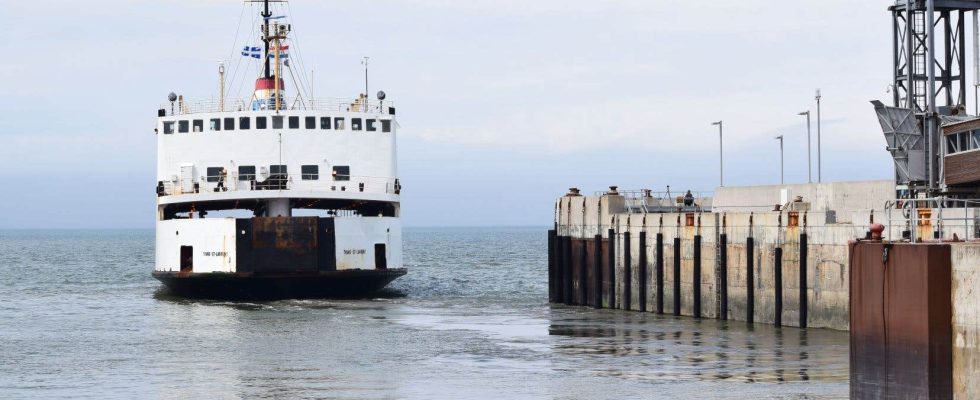The Société des traversiers du Québec is evaluating its options for the construction of a new wharf for the ferry that provides the link between Bas-Saint-Laurent and Charlevoix. The port of Gros-Cacouna, located in a sensitive habitat for the beluga, is one of the sites under study. The duty however, was unable to obtain details of the project’s development, despite three freedom of information requests.
The Société québécoise des infrastructures (SQI) has been mandated to develop a project that should ensure the sustainability of the river link between the Bas-Saint-Laurent and Charlevoix. The objective is to build a quay “for a lifespan of 50 years”, in order to put the vessel NM into service there. Saaremaa.
“The project will have to substantially reduce, or even eliminate, dredging and extend the service to the winter period, thus improving the current service”, specifies the “Dashboard infrastructure projects » of the Treasury Board Secretariat. You should know that the use of the Rivière-du-Loup wharf, from where the ship departsTrans-St-Laurent to get to Saint-Siméon, in Charlevoix, requires sediment dredging work on an annual basis.
The Société des traversiers du Québec (STQ) must therefore “evaluate different options in order to determine the optimal solution”, specifies the state corporation in a written response to our questions. “The current site of Rivière-du-Loup and the site of the port of Gros-Cacouna are being studied as part of the opportunity file,” it adds.
The possibility of moving the river link between the north and south shores of the St. Lawrence estuary is also a major issue in the region, due to the economic implications of the file. The Louperivois “wish to keep this essential service” at the current site and fear “major, even catastrophic, economic consequences for the tourist industry”, according to the municipality of Rivière-du-Loup. In Cacouna, on the contrary, they want to welcome the ferry, judging that the deep-water port would be able to offer the service, even if it has an industrial and commercial mandate.
The STQ, however, is stingy with comments on the development of the project. “The opportunity file follows the steps determined by the Directive on the management of major public infrastructure projects, and a decision should be rendered this spring,” we simply indicated by email.
Information refused
The duty attempted to obtain additional information concerning the new wharf project by using the provisions of the Act respecting access to documents held by public bodies and the protection of personal information.
The Ministry of Transport and Sustainable Mobility refused us access to the documents requested, citing the fact that they contain “analyzes, opinions and recommendations”, but also that a document was “intended for a member of the Council of ministers”.
The ministry referred us to the STQ, which also refused us access to the requested documents, citing four articles of the law. “After analysis, it is not possible to follow up on your request”, also replied the SQI, citing five articles of law.
“These documents were produced as part of an ongoing decision-making process, and their content is made up of analyses, opinions and recommendations. Since these documents consist in substance of information that is not accessible under the aforementioned articles, the documents are not accessible, ”writes the SQI.
The office of the Minister of Transport and Sustainable Mobility, Geneviève Guilbault, simply indicated that the project is “under study”.
Belugas
If it is not possible to obtain details concerning the analyzes in progress, the decision that will be made could prove to be important for the St. Lawrence beluga. Indeed, if the final choice stops on the port of Gros-Cacouna, the new wharf would be built in an area known as being a “nursery” of the species. The intensive use of the sector, in particular by females accompanied by young, was also reaffirmed by experts on the species as part of the Symposium béluga 2023, which was held in Montreal over the past few days.
“It’s a bit like the elephant in the room. If the ferry ever left Gros-Cacouna, it would greatly increase ship traffic. Currently, the port is relatively little used,” said the president of the Saguenay-St. Lawrence Marine Park Coordinating Committee, Émilien Pelletier.
“There are issues for the beluga in this sector, and the issues will arise very quickly with the expansion of the marine park, because the Cacouna sector will most certainly be included in the park,” he adds. The governments of Quebec and Canada announced earlier this year their intention to expand the area of the park to include all of the beluga’s critical summer habitat, which includes the Cacouna sector.
According to Mr. Pelletier, the evaluation of this environmental component of the project would therefore be essential, in particular to verify the impact of the ferry NM Saaremaa, which is currently used for the Matane–Baie-Comeau–Godbout river link. This ship, built in 2010, is larger, but newer than the Trans-St-Laurent, built in 1963. A project on the “acoustic signature” of STQ ferries is underway.
Professor of socio-ecological systems modeling at the University of Quebec in Outaouais, Clément Chion believes that “we currently lack information” to properly assess the potential impacts of the river link on belugas, whether it leaves from Rivière- du-Loup or Gros-Cacouna. “New studies should be carried out to analyze the real impact on animal behavior, the effects of disturbance, for example at the time of birth, etc. “, he underlines.
In addition to the decision regarding the future of the ferry in the region, the Quebec government must decide this year whether to authorize two recurring dredging and sediment disposal projects, for the ports of Rivière-du-Loup and Gros -Cacouna. However, there is no scientific study to assess the impact of these operations on the beluga.
With Dave Noel
